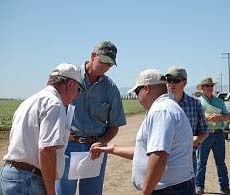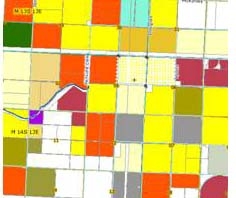Gathering in a cotton field near Mendota, CA, farmers, pest control advisers and UC Cooperative Extension gathered to discuss approaches to the challenges in cotto

Three main factors for Lygus management need to be considered:
What is the source?

Is it a strong source such as safflower or seed alfalfa which produces large numbers of Lygus as the crop is prepared for harvest? Is it alfalfa hay which can mitigate the movement of the pest if habitat is preserved? Is it weaker sources like tomato or other poorer hosts which produce far fewer?
How far from the source is the field? The greater the distance from the source, the less the threat. Even the strongest sources have a limited sphere of influence, perhaps no greater than 2 miles.
How many Lygus are in the field and how much threat do they present?
It is essential to frequently monitor and record the cotton fruit retention as well as the population density of Lygus bugs. Both are critical for making the best decision. Small numbers of Lygus in a field with poor retention is a greater threat than a larger population in a well fruiting field. Remember the cotton integrates all stress, bugs or weather, and reflects that in current fruiting conditions See details in Field Check link below.
What to use to control Lygus?
Chose your material carefully to limit resistance pressure on the pest target. Understand IRAC mode of action labels and utilize rotation of active ingredients. Start with the most selective products to preserve your valuable inventory of natural enemies and avoid secondary outbreaks of aphids, mites or whiteflies. Move to more broad-spectrum insecticides later in the season. For a summary of UC IPM Guidelines for Lygus, see link below.
Group consenus
All ageed that the next four weeks is the critical period for setting fruit and establishing yield. They also noted that 2011 is only slightly behind 2010 which was a good year, yield-wise. Good management, including conscientious monitoring and decision making for Lygus can go a long way in setting up the remainder of the year.
Finally, most agreed that time spent checking your fields is an investment, not an expense.
Attached Files: